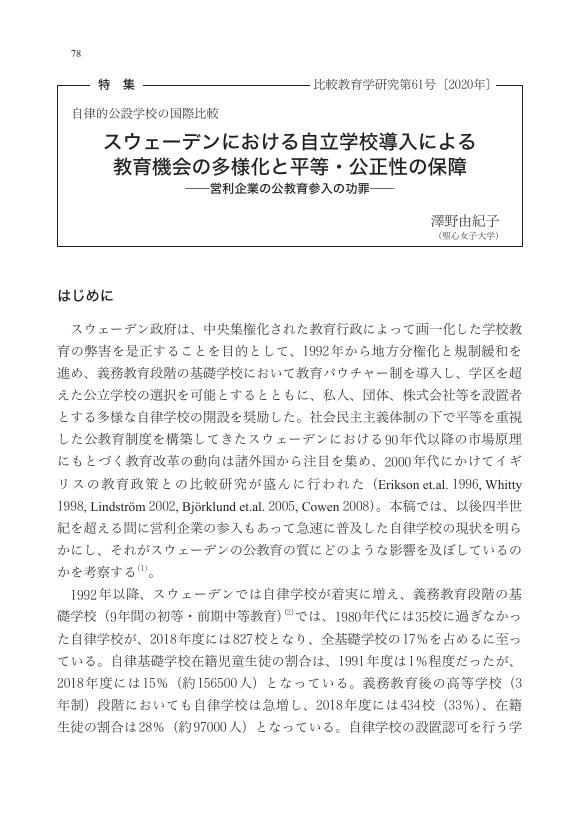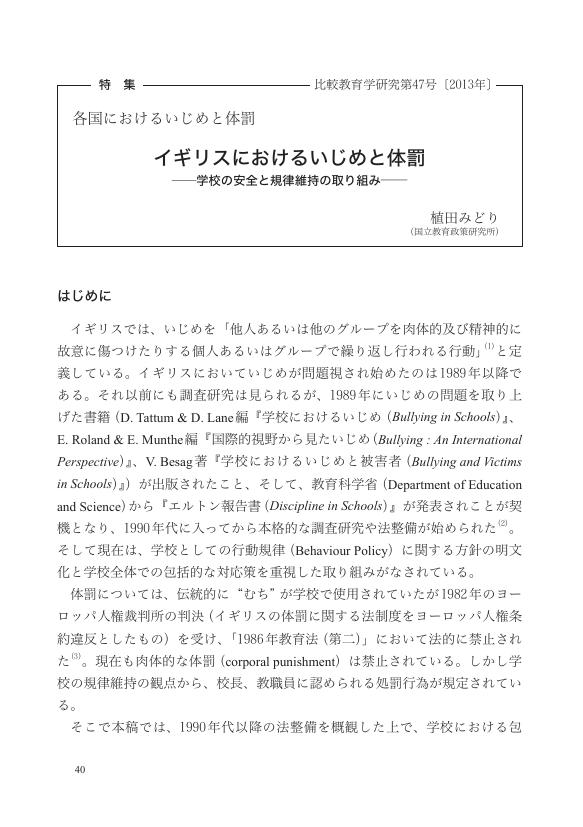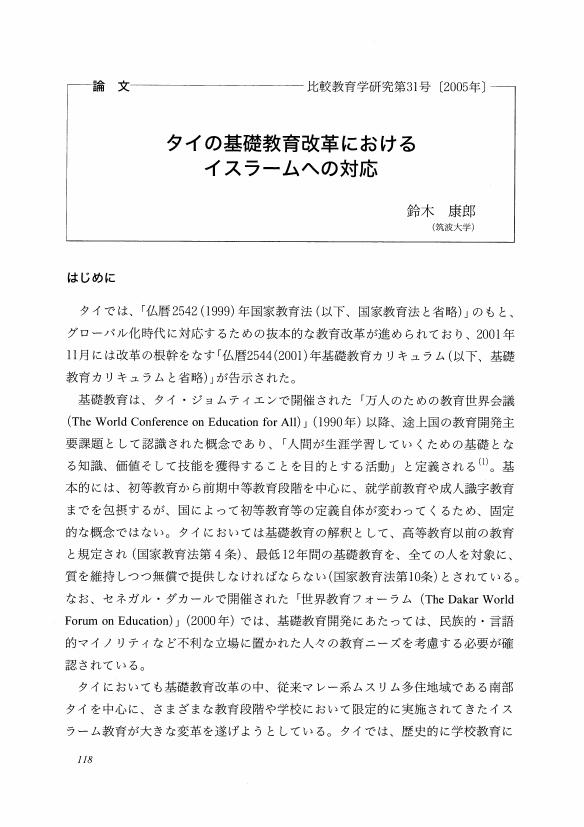14 0 0 0 OA 平田諭治著教育勅語国際関係史の研究
- 著者
- 佐々木 毅
- 出版者
- 日本比較教育学会
- 雑誌
- 比較教育学研究 (ISSN:09166785)
- 巻号頁・発行日
- vol.1998, no.24, pp.214-215, 1998-06-30 (Released:2011-01-27)
- 著者
- 福田 誠治
- 出版者
- 日本比較教育学会
- 雑誌
- 比較教育学研究 (ISSN:09166785)
- 巻号頁・発行日
- vol.1992, no.18, pp.157-166, 1992-06-25 (Released:2011-01-27)
7 0 0 0 OA 中国のエリート形成における高等教育・留学の効果
- 著者
- 大塚 豊
- 出版者
- 日本比較教育学会
- 雑誌
- 比較教育学研究 (ISSN:09166785)
- 巻号頁・発行日
- vol.1992, no.18, pp.53-64,202, 1992-06-25 (Released:2011-01-27)
This paper aims to elucidate the effects and implications for China of higher education and overseas study. For this purpose 1, 333 leaders in various fields who completed higher education and/or studied abroad have been extracted from persons listed in a “Who's Who in China” published by Shanghai Dictionary Publishing Company in 1989, and their school career and professional experiences analyzed.Ragarding schooling within China, 924 people (68.5%) are graduates of ordinary universities and colleges, followed by 204 (15.1%) graduates of some military institutions and 115 (8.5%) graduates of Communist Party schools and cadre training schools. As far as their academic specialities are concerned, those who studied engineering are the most numerous, amounting to 230 (17.2%). In contrast to China's strong image of a “super-gerontocracy”, many leaders are college graduates of the post-liberation era and the rejuvenation of various leaders has gradually been taking place. Generally speaking, what emerges is an image of leaders with knowledge and skills in science and technology, unlike the traditional image of Chinese leaders, who were inclined to be dominated by the literati.What deserves special mention is the fact as many as 309 people (23.2%) have experience of studying abroad. Judging from the country to which they went, there has been a clear “shift of center” according to the period, i.e. from Japan to the US, then from the US to the Soviet Union. Today one can clearly see the outcome of studying in the Soviet Union during the 1950s.Analyzing the professional careers taken up by these leaders and their academic specialities, the largest number have taken administrative or governmental jobs, and economics seems to be considered the most important discipline for a future bureaucrat. There are a few cases of mismatches but most of the bureaucrats with training in technology and agriculture as their academic background have been skilfully allotted to relevant posts. Party schools and cadre schools have played an important role in training those engaged in party-related jobs. Furthermore, among college professors, researchers, engineers, journalists, elementary and secondary school teachers, military personnel and judicial officers, there is also a high degree of coincidence between the academic speciality and subsequent professional career. Thus the effects of planned training and planned job allotment can be clearly recognized. In particular, the degree of coincidence of the administrative content of the work of Ministers and Vice-ministers with their past academic speciality is much higher than in Japan.
7 0 0 0 OA 教育バウチャーの効果と限界
- 著者
- 斉藤 泰雄
- 出版者
- 日本比較教育学会
- 雑誌
- 比較教育学研究 (ISSN:09166785)
- 巻号頁・発行日
- vol.2006, no.33, pp.75-95, 2006-06-23 (Released:2011-01-27)
- 参考文献数
- 24
6 0 0 0 OA チリ:新自由主義的教育政策の先駆的導入と25年の経験
- 著者
- 斉藤 泰雄
- 出版者
- 日本比較教育学会
- 雑誌
- 比較教育学研究 (ISSN:09166785)
- 巻号頁・発行日
- vol.2007, no.34, pp.156-170, 2007-01-30 (Released:2011-01-27)
- 著者
- 澤野 由紀子
- 出版者
- 日本比較教育学会
- 雑誌
- 比較教育学研究 (ISSN:09166785)
- 巻号頁・発行日
- vol.2020, no.61, pp.78-97, 2020 (Released:2023-07-19)
- 著者
- 朴 炫貞
- 出版者
- 日本比較教育学会
- 雑誌
- 比較教育学研究 (ISSN:09166785)
- 巻号頁・発行日
- vol.2011, no.42, pp.22-41, 2011 (Released:2023-07-19)
In this paper, the establishment of medical and law schools in the Republic of Korea are analyzed from the standpoint of institutional change. In the Republic of Korea, medical schools and law schools have been established since 2005 and 2009, respectively, with the Japanese system having been used since the pre-war period. The Japanese system appears to have been substituted with an American-style approach in light of the establishment of two distinct, professional schools. How might we come to understand the theoretical underpinnings of these changes? It is important to define ‘institutional change’ as a composite concept having two components, the change in qualifying requirements and the change of common expectations. ‘Institutional change’ occurs when an actors related to the institution recognize a change of environment. Actors who recognize this change then try to adapt to their new environs. In this process, there are conflicts among the various attendants or stakeholders who are related to the institution. When these conflicts occur, we can observe interplay of ideologies, contexts and features of a society, the impact of foreign countries, and leadership personalities related to these conflicts. In these processes, the revision of requirements and the formulation of common expectations occurs. To examine the conflicts related to institutional change, it is useful to refer to the power balance among actors related to the institution. The concept of ‘the regime of the training profession’ is applied in this study. This concept comprises three components in opposition to one another: government, professionals and the higher education system. Around the regime, there is society and a world that is recognized by the different components of the regime. ‘Institutional change’ is formed through a power dynamic and discussions about issues related to formalities. Two regimes serve as the foci of this paper: ‘training doctors’ and ‘training lawyers’. While distinct in and of themselves, the two regimes share mutual features. These include expectations of government and justifications for the establishment of the two schools, including (1) training ‘worldwide professions’ and (2) to reduce the effects entrance examinations from the undergraduate level upwards. The government expected the establishment of the two schools to be the solution to these problems for a variety of reasons. In the regime of training doctors, the government has heavy influence over medical schools through higher education policy, especially regarding the direction, supervision and administrative approval of, and financial support for, university institutions. Professors of medicine opposed and resisted these influences, but have been unable to articulate their arguments officially. Schools of medicine have therefore changed steadily since 2005. In contrast to the regime of training doctors, in the regime of training lawyers, a powerful legal profession was initially able to prevent the establishment of law schools though opposition to government policy. However, in the regime of training lawyers, the legal profession was critical in facilitating institutional change. Since 2003, the legal profession has led the reform of the judicial system and has come to adopt a more positive approach to the establishment of law schools and the Law School Act was approved in the Diet in 2007. The Act changed a key aspect of the regime of training, limiting the number of applicants admitted to law schools. While legal profession and nonlegal actors opposed each other on this issue, the legal profession has the ultimate authority to limit the number of law school admissions. In the lawyer training regime, there is one important feature related to the international sphere worthy of attention. (View PDF for the rest of the abstract.)
2 0 0 0 OA アラブ首長国連邦における国民と外国大学分校 ―教育ハブの中の「アラブ基盤型」発展論理―
- 著者
- 中島 悠介
- 出版者
- 日本比較教育学会
- 雑誌
- 比較教育学研究 (ISSN:09166785)
- 巻号頁・発行日
- vol.2016, no.53, pp.93-115, 2016 (Released:2020-08-29)
This paper clarifies the characteristics of two International Branch Campuses (IBCs) in the United Arab Emirates (UAE); Mohammed V University-Agdal Abu Dhabi (UM5A-Abu Dhabi) and the University of Saint Joseph-Dubai (USJ-Dubai). While IBCs in UAE have dramatically developed mainly for expatriate students, generally Emiratis prefer to study in federal universities for the perceived social well-being of Emiratis. It is said that UAE has developed as an Education Hub within the network of foreign institutions and students. However, almost all students in UM5A-Abu Dhabi and USJ-Dubai are Emiratis and it seems that these two IBCs have a theory of development different from that of an Education Hub. Clarifying the characteristics of these two IBCs will make up for the research blank and suggest the actual conditions of the regionalization of higher education in the Arab states. Firstly, the development of the higher education system in the UAE is investigated to clarify the systematical framework for IBCs. At the federal level, the Commission for Academic Accreditation (CAA) was established by the federal government to approve the establishment of institutions and accredit their programs. However, Dubai established economic free zones exempt from federal regulations and IBCs in these zones can choose to be under the federal regulation or Emirati regulation. Many IBCs in free zones choose to follow the regulation of the Dubai government, but they cannot be recognized as official institutions at the federal level nor affiliate with institutions accredited by the CAA, and graduates of these IBCs sometimes cannot work in federal institutions or other Emirates. On the other hand, Abu Dhabi has developed a different education system. The Abu Dhabi Education Council (ADEC) was established as governing body for education in Abu Dhabi and makes a huge financial investment in educational infrastructure with its rich oil resources. Economic free zones do not exist in Abu Dhabi and all IBCs must follow federal regulations. The regulatory environment for IBCs is therefore different between emirates, and each emirate has initiatives for building relationships with IBCs in accordance with their respective social economic environments. Next, the kinds of higher education institutions (other than federal universities) that Emirati students tend to study in are analyzed. While many Emirati students in Abu Dhabi prefer to study in non-federal public institutions, private higher education institutions providing legal education, media and Arab/Islamic studies hold many Emirati students in Dubai. In the UAE, Emiratization in public and private sectors remains a social problem. Especially, Emirati students hope to work in the public sector because of better working conditions, and the labor market in the public sector needs highly skilled Emiratis. In addition, the developments of UM5A-Abu Dhabi and USJ-Dubai are examined in terms of their management systems and educational programs. UM5A-Abu Dhabi is the IBC of Mohammed V University-Agdal in Morocco and was established in 2009 from the partnership between the ruler of Abu Dhabi and the king of Morocco. UM5A-Abu Dhabi provides bachelor, master and doctoral programs in Islamic studies and 11 Emirati graduates in 2013 gained employment as preachers within the Abu Dhabi government. In terms of management system, UM5A-Abu Dhabi has a board of trustees which consists of UM5A professors and governmental persons in Abu Dhabi. While UM5A has the initiative in academics, ADEC holds the initiative in administration and finance. Students do not pay tuition fees and they get scholarships from the financial assistance of the ADEC. UM5A-Abu Dhabi provides programs in Islamic studies to foster Emirati preachers and focuses on Islamic research and the practice of preaching. (View PDF for the rest of the abstract.)
2 0 0 0 OA 中国における少数民族高等教育政策-「優遇」と「統制」のメカニズム-
- 著者
- 小川 佳万
- 出版者
- 日本比較教育学会
- 雑誌
- 比較教育学研究 (ISSN:09166785)
- 巻号頁・発行日
- vol.20, pp.93-104,215, 1994
2 0 0 0 OA 「体罰」総論 ―比較研究のために―
- 著者
- 添田 晴雄
- 出版者
- 日本比較教育学会
- 雑誌
- 比較教育学研究 (ISSN:09166785)
- 巻号頁・発行日
- vol.2013, no.47, pp.13-25, 2013 (Released:2020-05-01)
2 0 0 0 OA イギリスにおけるいじめと体罰 ―学校の安全と規律維持の取り組み―
- 著者
- 植田 みどり
- 出版者
- 日本比較教育学会
- 雑誌
- 比較教育学研究 (ISSN:09166785)
- 巻号頁・発行日
- vol.2013, no.47, pp.40-50, 2013 (Released:2020-05-01)
2 0 0 0 OA 渡辺雅子著「納得の構造-日米初等教育に見る思考表現のスタイル-」
- 著者
- 恒吉 僚子
- 出版者
- 日本比較教育学会
- 雑誌
- 比較教育学研究 (ISSN:09166785)
- 巻号頁・発行日
- vol.2005, no.31, pp.281-283, 2005-06-25 (Released:2011-01-27)
2 0 0 0 OA 中国における少数民族高等教育政策
- 著者
- 小川 佳万
- 出版者
- 日本比較教育学会
- 雑誌
- 比較教育学研究 (ISSN:09166785)
- 巻号頁・発行日
- vol.1994, no.20, pp.93-104,215, 1994-07-01 (Released:2011-01-27)
- 被引用文献数
- 1
This paper deals with Chinese higher education policies for minorities focusing on the mechanisms of “preference” and “control.” The findings are as follows: First, the Chinese government established “Institutes of Nationalities”(Minzu Xueyuan) for the training of minorities' cadres. These “Institutes of Nationalities” originated with “Liberation Area-Type Colleges”, which put an emphasis on political-ideological education.Second, Chinese higher education policies for minorities are characterized as “preference.” Many of preferential policies have been instituted thus far, such as special treatments for minorities in the admission procedures and campus life of the “Institutes of Nationalities.”
- 著者
- 宮腰 英一
- 出版者
- 日本比較教育学会
- 雑誌
- 比較教育学研究 (ISSN:09166785)
- 巻号頁・発行日
- no.28, pp.28-40, 2002
2 0 0 0 OA アメリカにおける生徒懲戒リスクの再検証と懲戒に関する施策の動向
- 著者
- 片山 紀子
- 出版者
- 日本比較教育学会
- 雑誌
- 比較教育学研究 (ISSN:09166785)
- 巻号頁・発行日
- vol.2004, no.30, pp.110-128, 2004-06-25 (Released:2011-01-27)
- 参考文献数
- 44
2 0 0 0 OA フランスの公立小学校における学校週4日制実施の背景と課題
- 著者
- 小野田 正利
- 出版者
- 日本比較教育学会
- 雑誌
- 比較教育学研究 (ISSN:09166785)
- 巻号頁・発行日
- vol.1997, no.23, pp.15-24, 1997-05-30 (Released:2011-01-27)
- 参考文献数
- 10
2 0 0 0 OA 中国における愛国主義教育の展開
- 著者
- 武 小燕
- 出版者
- 日本比較教育学会
- 雑誌
- 比較教育学研究 (ISSN:09166785)
- 巻号頁・発行日
- vol.2008, no.36, pp.25-44, 2008-01-30 (Released:2011-01-27)
- 被引用文献数
- 1
2 0 0 0 OA マリオンM. スコットと日本の教育
2 0 0 0 OA タイの基礎教育改革におけるイスラームへの対応
- 著者
- 鈴木 康郎
- 出版者
- 日本比較教育学会
- 雑誌
- 比較教育学研究 (ISSN:09166785)
- 巻号頁・発行日
- vol.2005, no.31, pp.118-137, 2005-06-25 (Released:2011-01-27)
- 著者
- 安藤 万奈
- 出版者
- 日本比較教育学会
- 雑誌
- 比較教育学研究 (ISSN:09166785)
- 巻号頁・発行日
- no.37, pp.46-56, 2008












